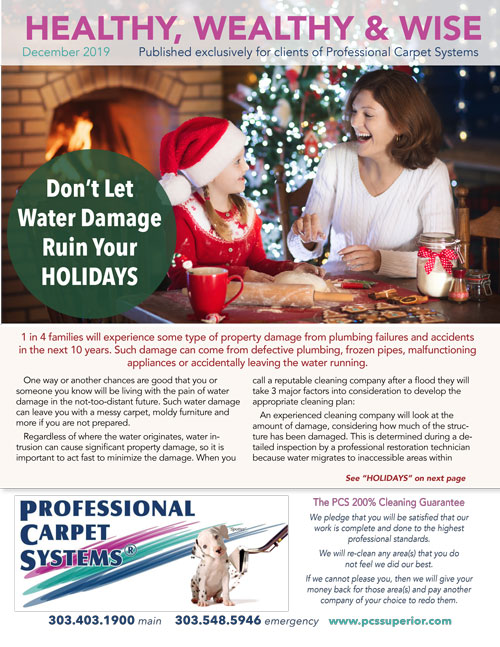Here’s our December 2019 Client Newsletter.
Click to see the full newsletter
Don’t Let Water Damage Ruin Your Holidays
1 in 4 families will experience some type of property damage from plumbing failures and accidents in the next 10 years. Such damage can come from defective plumbing, frozen pipes, malfunctioning appliances or accidentally leaving the water running.
One way or another chances are good that you or someone you know will be living with the pain of water damage in the not-too-distant future. Such water damage can leave you with a messy carpet, moldy furniture and more if you are not prepared.
Regardless of where the water originates, water intrusion can cause significant property damage, so it is important to act fast to minimize the damage. When you call a reputable cleaning company after a flood they will take 3 major factors into consideration to develop the appropriate cleaning plan:
An experienced cleaning company will look at the amount of damage, considering how much of the structure has been damaged. This is determined during a detailed inspection by a professional restoration technician because water migrates to inaccessible areas within the structure, requiring specialized knowledge and equipment to find out where the water is. Failure to locate hidden pockets of moisture can lead to further structural damage and the potential for lingering odors and mold growth.
A good company will consider the level of contamination, that is where the water came from, how it might be contaminated and how long it sat.
Category 1- Clean water comes from a source such as a broken water pipe, water heater or a sink overflow.
Category 2- Unsanitary water contains a significant amount of contamination such as soil, household chemicals, or organic material that can provide nourishment for bacteria and fungi. Sources include washing machine or dishwasher overflow, fish tanks, etc.
Category 3- Grossly unsanitary water contains contaminants that can cause disease. The most common source of Category 3 water is backflow from sewer or septic systems, or any water that passes over the ground due to fungi, bacteria, animal waste, pesticides, fertilizers and other potential contaminants.
A reputable company will also look at the depth of penetration, considering how deep water has penetrated into structural materials. Depth of penetration depends on the permeance of affected materials and the length of time the water remained in contact with those materials. Permeance is the ability of water to absorb into or pass through a material.
Drywall is highly permeable, absorbing water easily, while hardwood floors are low-permeance (minimally absorbent). The permeance factor, exposure time and level of contamination in the water, determines what materials can be saved. For example, if drywall is saturated only for a short time and with clean water, it can usually be saved.
However, if drywall is saturated with water from a sewage backflow, it should be removed and replaced. There are different requirements for various materials and the different levels of contamination.
If you consider all of the materials in your home as well as your furnishings, it’s easy to see why water intrusion means that you should call in experts at assessing the damage and tailoring a restoration program to your unique situation. You need technicians who are trained to minimize the damage and protect the health and safety of your family and who will act quickly and efficiently to get your home or business dry and clean, so you can get back to normal quickly.
Call Professional Carpet Systems today to schedule a visit or for more information. Don’t let water damage ruin your holiday season.

